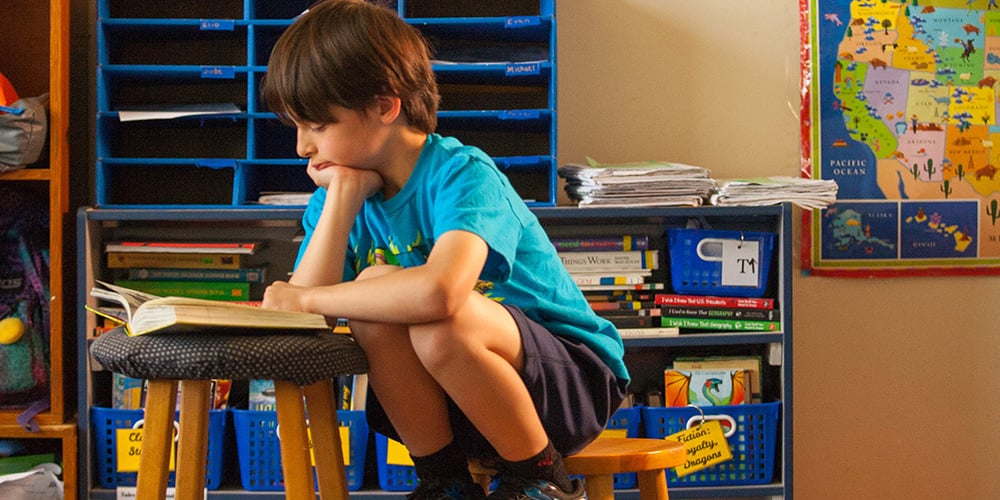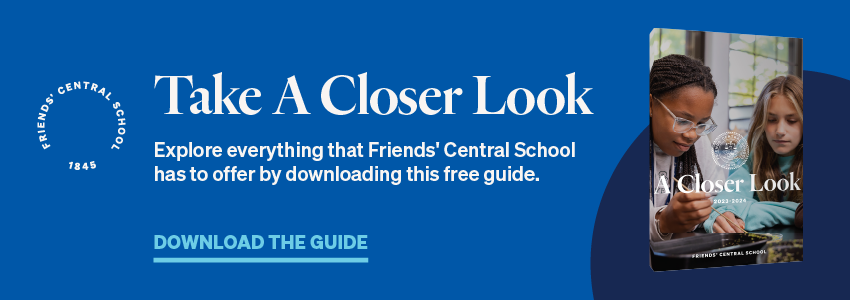
Few things are as important for healthy childhood development as reading. From exposing children to other locations and cultures and encouraging empathy, to improving critical thinking skills and concentration, the benefits of childhood reading are vast and imperative to a child’s growth.
For parents and caregivers however, getting a child to enjoy reading can be a daunting task. Busy schedules, lack of focus, and the distraction of omnipresent technology can make fitting reading for fun into the routine seem impossible. But laying a foundation of reading fosters independence in children and inspires a lifelong love of learning that ensures enthusiastic, well rounded, and independent students.
Free Downloadable Guide: Take a Closer Look at Friends' Central School
Fortunately, there are many easy and enjoyable ways parents and caregivers can encourage their children to read and help foster an enjoyment of reading from an early age. Factoring reading into your family’s everyday schedule, reading with your children, exploring your child’s interests and passions, and celebrating literature in a variety of mediums can help lay the groundwork for a life of reading exploration.
How to Encourage Kids to Read
1. Create a print-rich environment.
Creating a print-rich environment is the key to creating a curious learner. When children see books all around them, they realize that reading is important to their household, and it naturally becomes important to them as well.
Print-rich environments are areas and surroundings that feature print in a variety of different forms and purposes and allow your young learner the agency to choose their own ready journey. These environments serve as examples and reminders of the many uses of the written word and instill a natural sense of curiosity and exploration.
Children who grow up in print-rich homes can choose their own reading material and work at their own pace. This sense of ownership and freedom to explore allows children to naturally enjoy reading and learning.
Slaughter suggests parents and caregivers ensure that every surface of their home features something to read. Examples of materials found in print-rich environments include:
- Books
- Magazines
- Newspapers
- Letters and Cards
Print-rich environments also provide an incredible opportunity to expose young learners to multicultural material. Through reading, children are exposed to people, places, and events throughout the world—and history—and can expand their worldview to include ideas, beliefs, and insights beyond their own experiences.
2. Read as a family.
Parents and caregivers who want to make reading an enjoyable activity for their child should begin by incorporating books into their child’s daily routine and environment as early as possible. Though it might not seem impactful, parents who help their babies and toddlers flip through board books and early reading materials and talk to them about what they’re seeing on the pages helps little ones stay engaged and associate reading with the familiarity and comfort of their loved ones and role models. This association instills a positive reaction to reading even at the earliest stages that paves the way for a life of reading enjoyment.
As your child gets older, having them read to you allows them to share and express their interests and passions while strengthening their reading and comprehension skills. You might ask your child questions about what they’ve read to you and seek their opinions on what they’ve read and how they can think critically and apply their other experiences to what they’ve read.
Engaging in this way not only inspires conversation but also creates opportunity for families to bond and provides a natural outlet for curiosity. And there are many fun and creative ways for families to couple reading and togetherness.
- Following recipes to prepare dinner together
- Word games like Scattergories, hangman and charades
- Scavenger hunts
- Acting out stories and scenes from favorite books
- Reading to far away friends and relatives via Zoom and Skype
- Read books and then watch the movie—and vice versa!
3. Make reading active.
Parents and caregivers should also work to make reading an active exercise for their young learners. By creating an environment where readers are encouraged to actively seek out what they want to read, learn, and explore, they enable their children to truly learn and comprehend.
Children can find active reading opportunities by participating in reading challenges, picking new series to explore, and reading for research and reports. This foundation in learning creates truly independent pupils who are empowered to choose their own journey and begin to love the process of reading and learning together.
4. Make reading fun.
Finally, if you find that your child struggles with reading certain kinds of text, such as non-fiction, it’s important to find ways to still make reading fun for them so that they don’t stress about it or begin avoiding it.
One way to do this is to remember that not all reading needs to be academic. If your child is primarily reading non-fiction during the school hours, encourage them to choose a different genre, such as fiction or poetry, when they are reading at home. Alternatively, if they need to or want to read non-fiction, encourage they choose a subject that you know interests them and not just one that they think will help them get ahead in school.
Raising Engaged Readers is a Group Effort
The opportunities for parents and caregivers to foster a love of reading in their child are plentiful. From crafting environments that encourage and engage their young learner, to reading as a family, to encouraging their child to actively engage in reading, parents can set their child up for a positive life-long relationship with reading and learning as a whole.
But what to do when your child doesn’t demonstrate a love of reading? Enrolling your student in a school or program that ensures students have ready access to books and material that increase and indulge their curiosity is key in ensuring young learners develop a positive relationship with reading.
Friends’ Central School’s Blackburn and Lower School libraries provide thousands of resources to create passionate, enthusiastic, independent learners and strive to inspire a lifelong love of reading. Friends’ Central School prioritizes creating invested and active readers and learners, and teachers and staff work alongside parents and caregivers to provide a consistent example of the joys and benefits of reading.
Working hand-in-hand with parents and caregivers, teachers and staff at Friends’ Central School can serve as an extension to their family’s reading philosophy and can help reinforce the focus and importance placed upon reading. With this well-rounded approach, parents can be sure they are raising engaged, enthusiastic and informed readers, and setting them up for a positive lifelong relationship with the written word.


